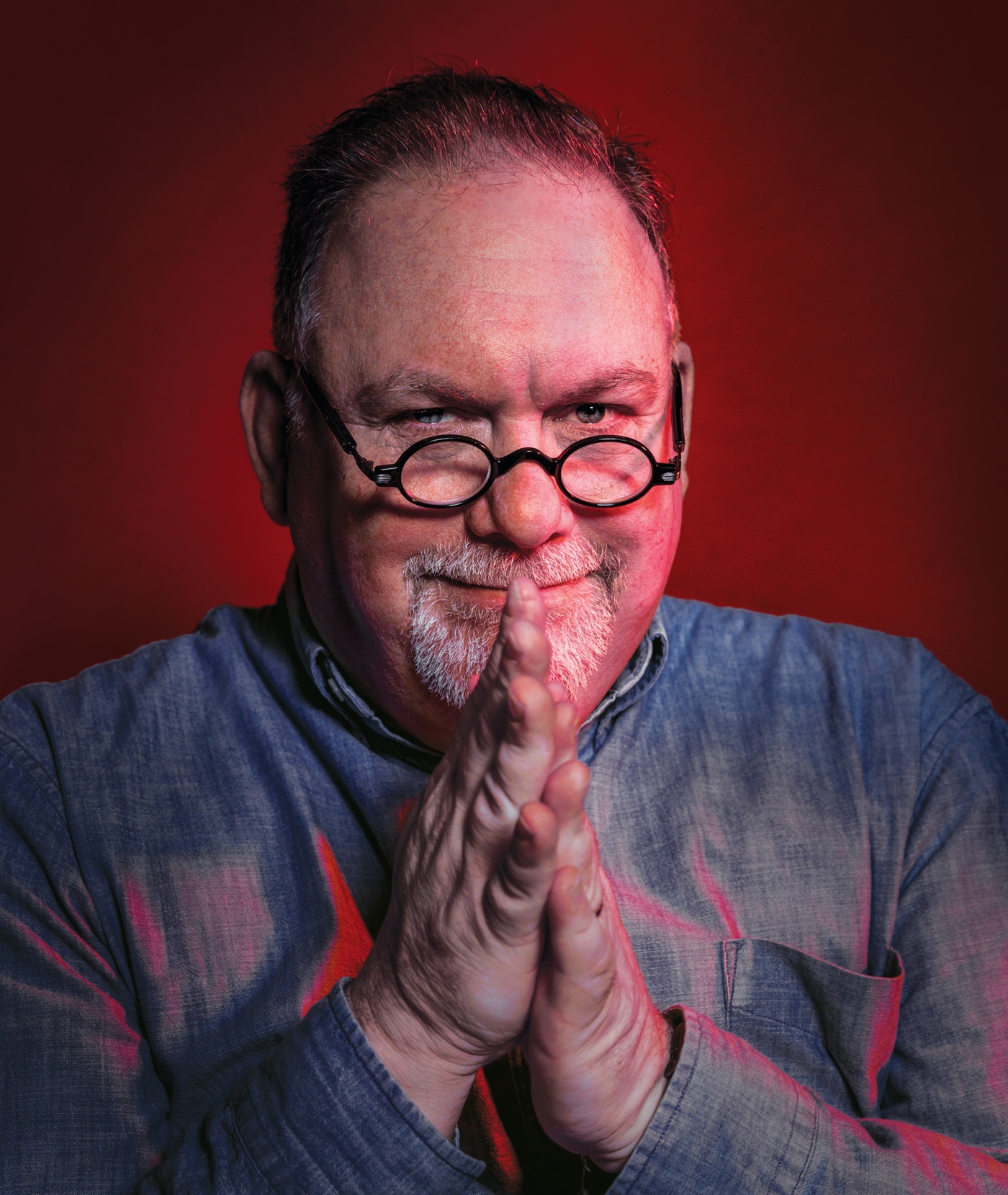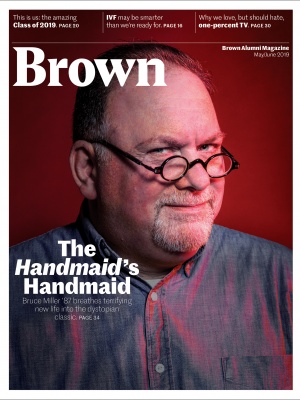When television writer and producer Bruce Miller ’87 made his pitch to the executives planning to adapt Margaret Atwood’s The Handmaid’s Tale, the dystopian 1985 novel he’s loved ever since he read it in a Brown English seminar three decades earlier, he wasn’t thinking of seizing a political moment. Nor was he necessarily convinced he was the right person to helm the new show. He just really wanted to see it get made.
Miller was a successful Hollywood journeyman at the time, going from show to show, getting fired a lot and learning a lot, as he put it in an interview. But he was not a household name.
And there was an elephant in the room: Miller is a man and Atwood’s book is a seminal work of feminist literature. It’s set in a parallel present in which, in the midst of an environmental crisis that has caused fertility rates to plummet, fundamentalist revolutionaries have overthrown the United States and created a violent theocracy called Gilead. The luckiest women are confined to the home as wives of the “commanders” who run the new country. The unlucky majority are conscripted into various subservient roles, one of which is that of “handmaids”—women who, having been stripped of former lives, families, and identities, and undergone reeducation in brutal training camps, are subjected to ritualized rape aimed at providing children to the ruling class. The book and series are narrated by a handmaid renamed Offred—or Of Fred—for her assigned commander.
Indeed, the show sponsors initially sought a female showrunner—the person with both creative and managerial control of a show. Miller agreed with that premise even as he won them over.
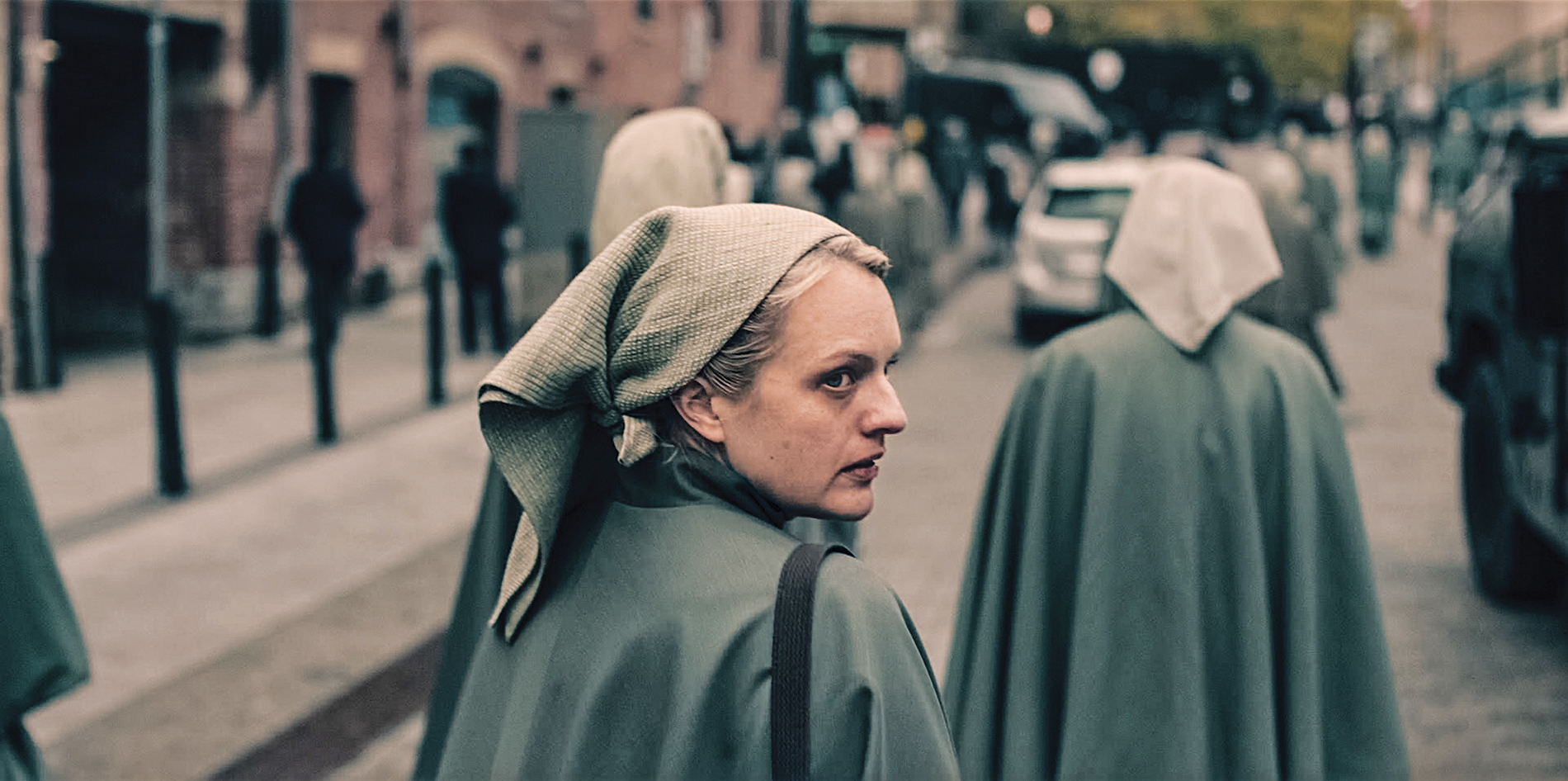
What came out of nowhere was the context. While the series was conceived well before the 2016 election, Hulu launched The Handmaid’s Tale in April 2017, three months into the Trump era, with seemingly settled advances in women’s and LGBTQ rights facing pushback, ultra right-wing populism inching into the mainstream, and press freedoms under official challenge. The administration’s practice of separating children from parents fleeing danger and oppression, which echoes the very first scene in the series, came later. Before the show started streaming, the presidential election results had Atwood’s book back on the bestseller lists with similar volumes such as Brave New World, 1984, and It Can’t Happen Here. At the massive women’s protest the day after President Donald Trump’s inauguration, marchers carried signs reading “Make Margaret Atwood Fiction Again” and “The Handmaid’s Tale is NOT an instruction manual.” Women started dressing in the handmaids’ signature red robes and white head pieces to protest efforts to restrict reproductive rights, including anti-abortion legislation under consideration in the Texas Senate.
“It isn’t scary unless it’s real. It’s just goofy people in costumes.”
The show’s hotly anticipated debut felt like a genuine cultural milestone.And the series delivered, big time. The New York Times’s James Poniewozik called it “a cautionary tale, a story of resistance, and a work of impeccable world-building. It is unflinching, vital, and scary as hell.” The New Yorker’s Emily Nussbaum wrote that “Trumpian parallels are hard to miss. It’s a story about a government that exploits fear of Islamic terrorists to crush dissent, then blots out women’s reproductive rights. It’s about fake news, political trauma, the abnormal normalized.”
Awards followed, including a total of 11 Emmys so far, plus a prestigious Peabody. Yet Robert Thompson, professor of television, radio, and film at Syracuse University, argues that the show owes its prominence to more than good timing. The debut’s political context “certainly raised the voltage and gave something for all the critics and reviewers to talk about,” Thompson says. “However, I think in the end what made the show successful is that it’s really beautifully executed.”
For his part, Miller, who is in charge of everything from hiring to editing, from budgeting to mapping out the story and the show’s look, both acknowledges the timeliness and pushes back. To be deemed relevant has been “very humbling and scary and amazing,” he says. And while he started writing pilot scripts before he even knew who was running for president, reality has definitely informed his choices.
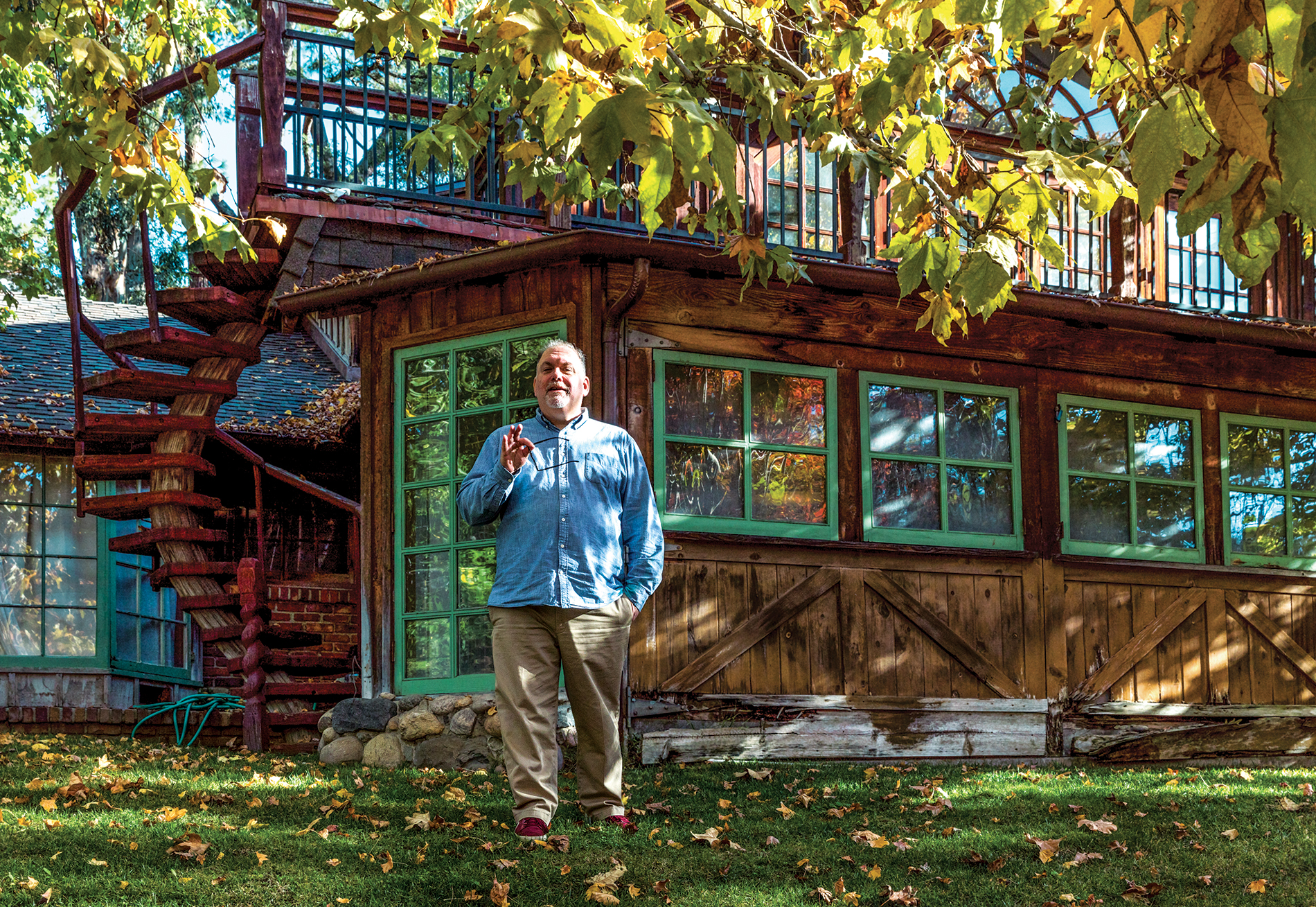
“As a show, we don’t ever go after what’s timely,” he explains, but “we read the newspaper every morning, and the things we read end up in there.” Or in some cases, they don’t. In one of the show’s chilling flashback scenes of the time before the revolution, for instance, a character had a line about making the country great again. It felt like too much: “We had to cut that out.”
Still, Miller points out that the book’s themes are timeless. Atwood “touched on these unfortunately never-ending dynamics between men and women, and power structures. Every time I’ve read it, it’s like, ‘now is the perfect time to read it.’”
The show’s first season closely tracks the book, while its second continues the story beyond Atwood’s initial arc—which gave Miller the chance to imagine what comes next and has prompted healthy debate among fans regarding his choices. Season Three is expected to debut June 5.
From the beginning, adapting the written text to television called for some big decisions and some seemingly small ones that loomed large.
In the latter category was the question of color. In the visually rich universe of the show, women of different castes are assigned certain clothing. The wives wear blue, the “Marthas” or household servants wear drab grayish-green, and handmaids wear red dresses and cloaks. In the book, it takes just a word or two to convey the feel of each color—Atwood dressed the Marthas in “dull green” in her novel—but television required that Miller decide which of the hundreds of shades of red, for instance, would work best for his handmaids. After much debate, Miller decided to base his costumes on colors in medieval art. Beyond that, the clothes needed to look lived-in and consistent with the story—
Gilead would use natural fabrics, for example. The handmaids’ red cloaks would be exposed to the sun and drag on the ground, so they should fade at the shoulders and show wear and tear.
“This show lives or dies on attention to detail,” Miller observes. “It isn’t scary unless it’s real. It’s just goofy people in costumes.”
Among the bigger decisions Miller made was to make the commander Fred and his wife Serena Joy closer to Offred’s age, to give the two female characters a more direct, vibrant rivalry. Their past lives overlap as well. June, Offred’s real name in the show (it was never disclosed in the book), had been an editor. Serena Joy was a writer whose book on a woman’s place provided grist for the revolution. In the new world, both are legally banned from reading (in an entirely believable example of the rule-makers feeling free to create their own exemptions, Serena Joy’s husband invites Offred to his book-lined study for illicit games of Scrabble).
While he started writing pilot scripts before he even knew who was running for president, reality has definitely informed his choices.
Another big decision: subverting the book’s take on race. In Atwood’s telling, Gilead is a white supremacist society, with everyone else banished to unseen “colonies” to clean up toxic waste. Miller dispensed with that, reimagining the society as colorblind. Part of his reasoning was that it’s problematic to make an all-white show these days, and part was that he wanted the look to be more contemporary, to emphasize that the events take place in the present. Modern evangelicalism has become more diverse, he notes, and it’s increasingly difficult to sort people into easy categories.
In the show, June—played by Elisabeth Moss —is white, her husband Luke and best friend Moira are black, and the daughter who’s seized and given to a ruling class family is biracial. Miller says none of this was intentional but rather the result of opening up auditions to everyone and choosing the actors with the best chemistry.
June and Luke “look like the couples you see in Cambridge,” where the story is based.
While the book is restricted to Offred’s observations, television also allows Miller to show what’s happening away from the main action, in the colonies and among Americans who’ve escaped to Canada and are resisting from afar.
Yet in other ways, Miller sticks close to Atwood’s conception. In the book, everything that happens has occurred at some point in history; the same goes for the show. That, he argues, is what keeps horrific scenes of genital mutilation and severed tongues from turning into “torture porn.”
“People say it’s violent,” Miller says. “Yeah, I’m sorry, that’s the world.”
Mixed in with all this is Miller’s determination to make the narrative true to women’s experiences, something he knew he had to do when he first got the job. His approach is to try to know what he doesn’t know—to surround himself with female writers and listen to them. An example: what happened when he set out to write a scene involving menstruation. He asked the show’s writers what the experience is like, and got not one answer but a whole range. An important lesson, he says, is that you get more information about the “scope of experiences” when more than one member of a group is in the room.
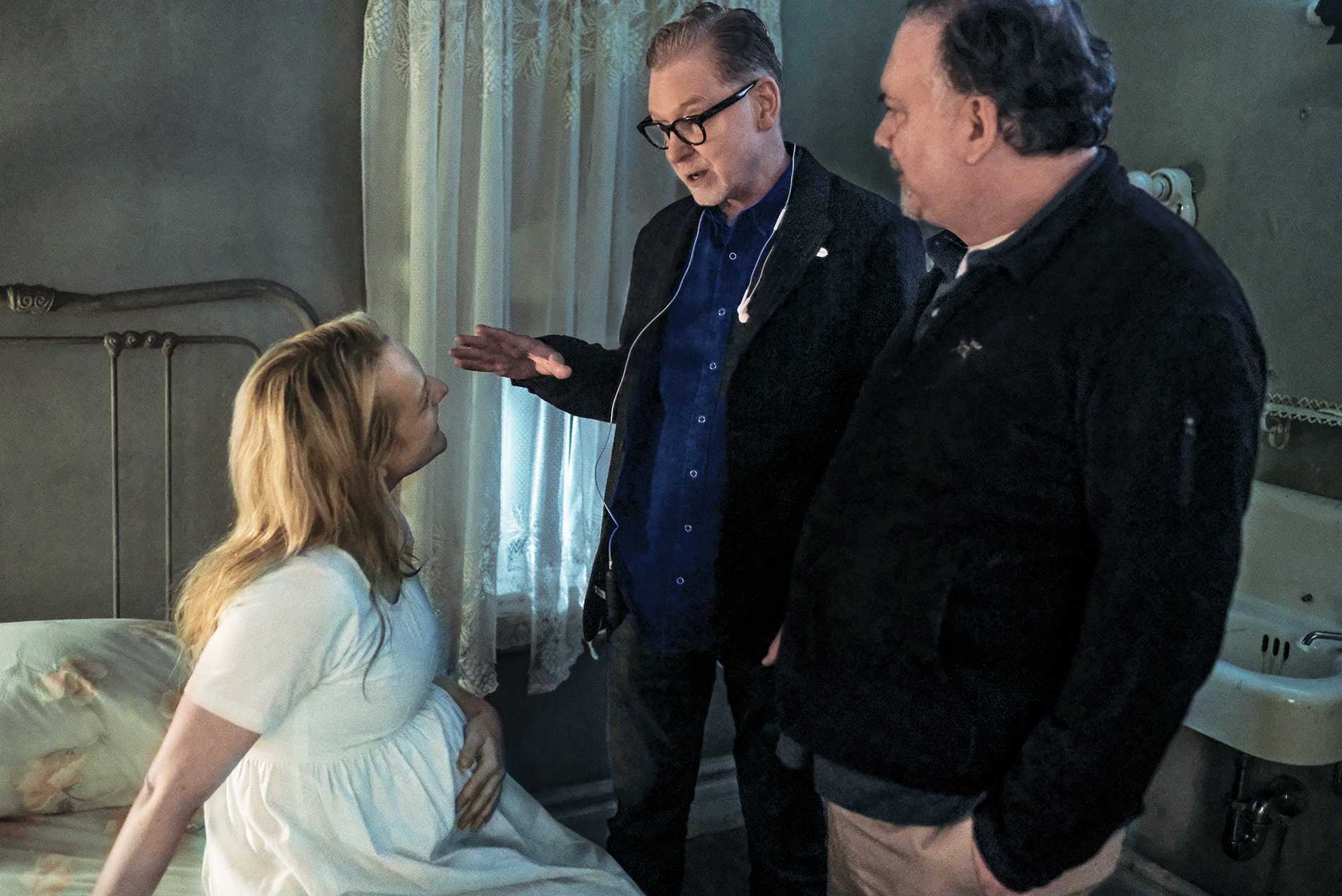
Atwood, whose sequel to The Handmaid’s Tale, The Testaments, is due out in September, is a consulting producer on the show, so the two talk regularly about her choices and her take on the characters. Miller asks questions that might otherwise be the subject of dry academic analysis, such as why she chose to use language from the King James Bible as opposed to the Geneva Bible that the Puritans favored. It’s prettier, Atwood told him.
They also talk out the story’s larger arcs.
“Having access to her in those ways is kind of magical to me,” he says.
It was actually Atwood’s writing, not her political vision, that first drew Miller to the book. He was an English and American Literature concentrator and writing fellow at Brown, and he says The Handmaid’s Tale was “one of the first books that taught me how to think out a point of view.”
Miller’s parents, Stanford Miller ’54 and the late Barbara Mesirow Miller, met at Brown. His mother was originally Brown ’54, though she finished up elsewhere after her father got sick. His two sisters are also alums, and Miller’s son, Duncan ’21, is finishing up his sophomore year. It was something of a show business family. When Bruce was a child in Stamford, Connecticut, his father made theatrical supplies for Broadway, so he grew up with an understanding of the technical side of the business. He set off for Los Angeles after college with the goal of writing and eventually earned enough money writing movie scripts to make a comfortable living, even though they generally didn’t get made. Television became his favored medium because “you’re shooting with live ammo,” as he puts it. His highest-profile TV credits before The Handmaid’s Tale were on ER, Medium, Eureka, and The 100. The Handmaid’s Tale’s success will likely enable him to keep shooting as long as he wants.
He’s exploring aspects of this dystopian society that the book just hinted at—including some that have only played out in his head.
Syracuse’s Professor Thompson, who has studied the era of prestige scripted television, says the show has catapulted Miller into the elite club of television visionaries. “Bruce Miller’s name is now mentioned in the same sentence as Vince Gilligan and Shonda Rhimes,” Thompson says—strong words considering Gilligan created Breaking Bad while Rhimes has a string of hits including Grey’s Anatomy and Scandal. “The Handmaid’s Tale,” Thompson adds, “is the show that establishes Bruce Miller as one of these brilliant TV auteurs.”
Earlier this year, Miller signed a major development deal with Hulu and MGM Television, the show’s current producing partners. In announcing it, Hulu’s vice president of content development Beatrice Springborn called Miller a “one-of-a-kind partner and storyteller.”
In the meantime, he’ll remain at the helm of Handmaid through the upcoming season and for the foreseeable future.
It’s an assignment he still relishes three years in, now that the story has extended beyond Atwood’s original cliffhanger ending. Even as a fan, he says, his goal was never to adapt the book but to “bring the tone and the language, the sense of place and the sense of terror, to life.” Producing the show has allowed him to explore aspects of this dystopian society that the book just hinted at—including some that, to date, have only played out in his head.
For instance, Miller says he’d “love to see the Nuremberg trial of the Commander and Serena Joy. When you read the book, you’re furious when it ends. I get the chance to say, well, maybe it goes that way.”
Stephanie Grace ’87 is a political columnist at the New Orleans Advocate and a contributing editor at BAM. She lives in New Orleans.

